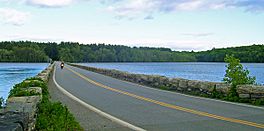West Branch Reservoir facts for kids
Quick facts for kids West Branch Reservoir |
|
|---|---|

The Carver Bridge, where NY 301 crosses the reservoir
|
|
| Location | Putnam County, New York |
| Coordinates | 41°25.5′N 73°42′W / 41.4250°N 73.700°W |
| Type | Reservoir |
| Primary inflows | West Branch of the Croton River |
| Catchment area | 20 sq mi (52 km2) |
| Basin countries | United States |
| Surface elevation | 490 feet (150 m) |
The West Branch Reservoir is a large, man-made lake that holds water. It is an important part of the New York City water supply system, which provides drinking water to millions of people. This reservoir was created by building a dam across the upper part of the West Branch of the Croton River.
You can find the West Branch Reservoir in Putnam County, New York, specifically in the towns of Kent, New York, and Carmel, New York. It's about 50 miles (80 km) north of New York City.
Contents
What is the West Branch Reservoir?
The West Branch Reservoir started working in 1895. It is one of 12 reservoirs in the Croton Watershed system. A watershed is an area of land where all the rain and snowmelt drain into a common body of water, like a river or a reservoir. The Croton Watershed is a major source of water for New York City.
How the Reservoir Gets Its Water
The West Branch Reservoir receives water from a few different places:
- It gets water from the Boyds Corner reservoir, which is upstream.
- Sometimes, it also gets water from Lake Gleneida.
- Most importantly, it receives a lot of water from the much larger Rondout Reservoir. This water travels all the way from the Catskill Mountains through a long underground tunnel called the Delaware Aqueduct. An aqueduct is like a giant pipeline that moves water over long distances.
The West Branch Reservoir acts like a big settling pool for this water. It helps clean the water before it continues its journey through the aqueduct to the Kensico Reservoir in Westchester County.
Reservoir Size and Capacity
The area of land that drains into the West Branch Reservoir is about 20 square miles (52 km2). This reservoir can hold a huge amount of water, up to 8 billion US gallons (30,000,000 m3) when it's completely full! The reservoir is actually made up of two separate parts, which are divided by State Route 301.
Water During Dry Times
During times when there isn't much rain, called droughts, the West Branch Reservoir can also get water from the Hudson River. This water is pumped in by a special station near Beacon in Dutchess County. This pumping station is about 65 miles (105 km) from New York City. This method was used during droughts in 1965–66, 1985, and May 1989 to make sure New York City had enough water.
How Water Reaches New York City
Water from the West Branch Reservoir usually travels through the Delaware Aqueduct to the Kensico Reservoir in Westchester County. At Kensico, the water settles even more. It also mixes with water from another system called the Catskill system, which comes through the Catskill Aqueduct.
After Kensico, the water enters a series of tunnels that carry it to the Hillview Reservoir in Yonkers. This is right at the edge of New York City. From Hillview, the water flows through more tunnels to reach homes and businesses in the city's different areas, like The Bronx, Queens, and Brooklyn. The water supply system eventually reaches Staten Island.
When There's Too Much Water
If the West Branch Reservoir has more water than New York City needs, the extra water flows over its spillway. A spillway is like an overflow drain. This water then goes into the West Branch Croton River, and further downstream, it is collected by the Croton Falls Reservoir.


